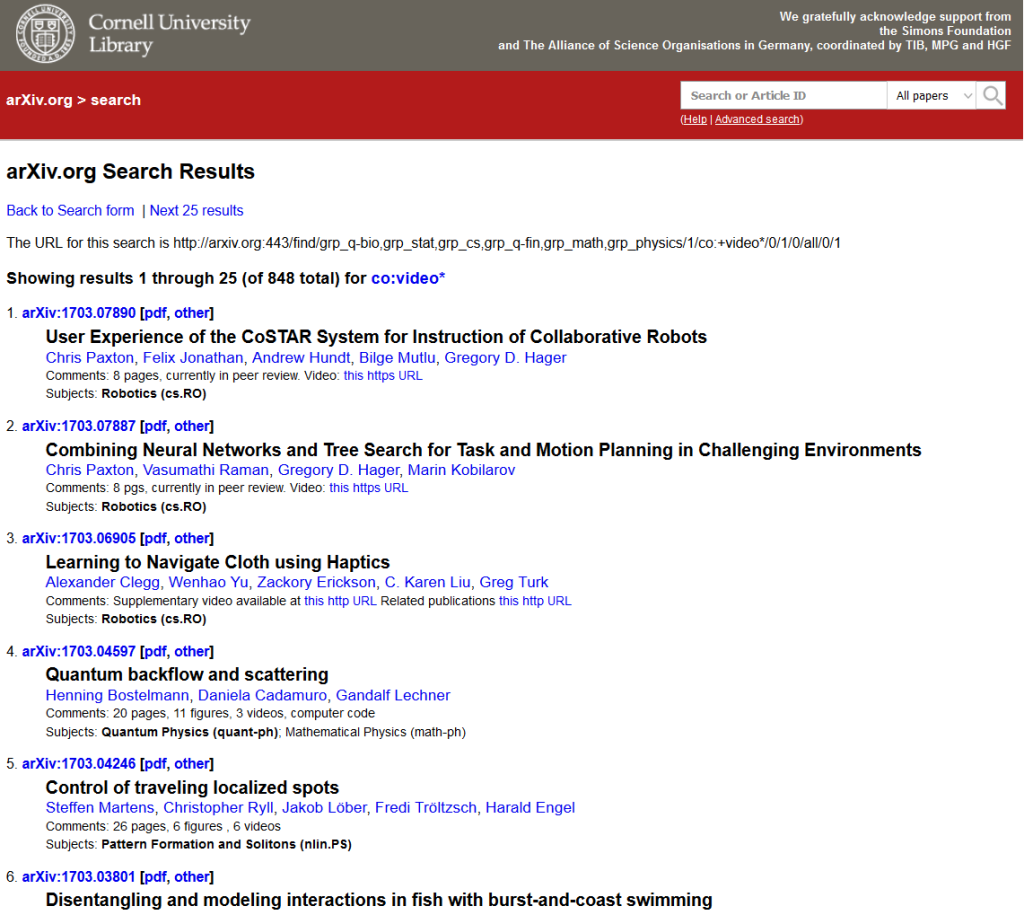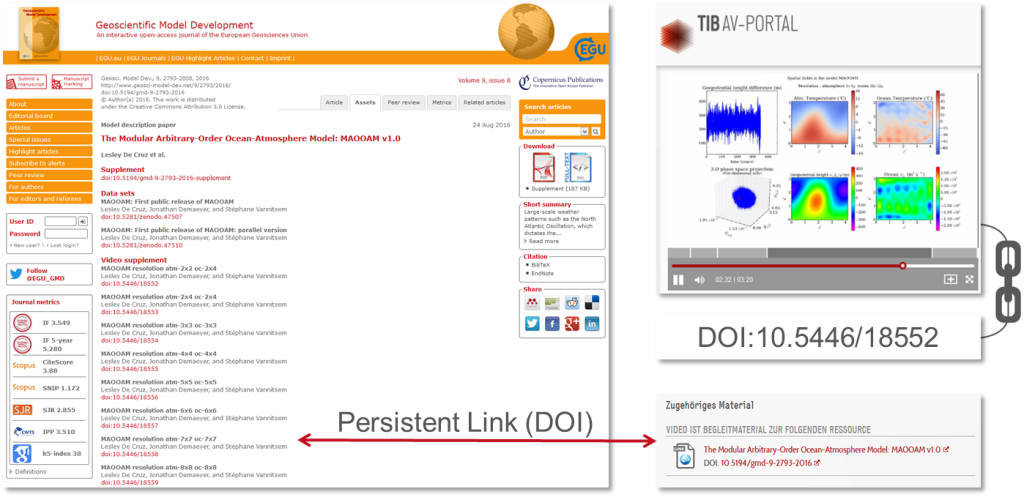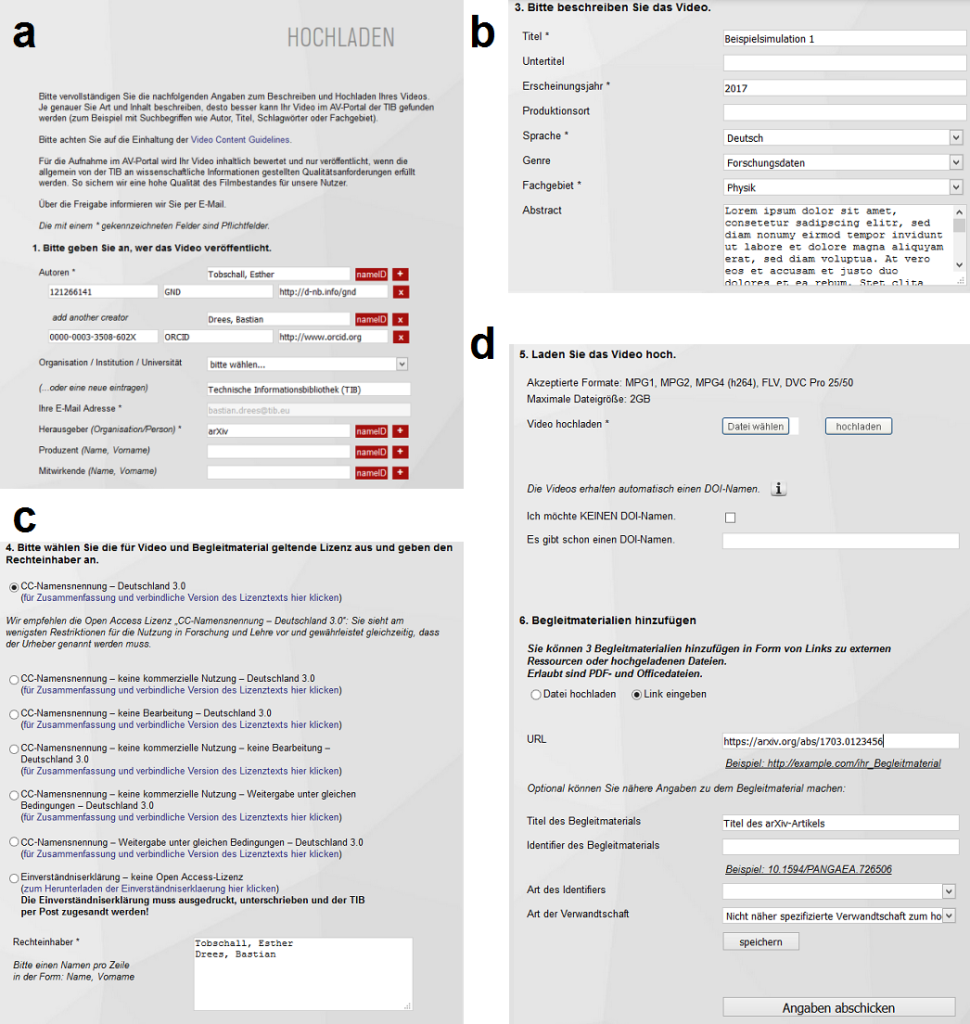Alternative facts – or: How arXiv authors treat their video supplements!
An article by Esther Tobschall and Bastian Drees
It’s a fact that scientific publications are much more than just texts. Even if a journal article still seems to be the be-all and end-all in science, supplemental information such as research data, software code, visualisations of simulations, and recordings of experiments is increasing in importance.
It’s another fact that such non-textual research results have been present in science all along. But it is only since the advent of electronic publications that it has been possible to include or add them appropriately to scientific publications. Previously, results were described in articles and, where possible, presented as graphics, diagrams or video snapshots (cf. Fig. 3). Today, there exists a huge variety of freely available tools and platforms that allow such results to be made publicly available, for example YouTube, Zenodo, GitHub, etc. Moreover, many scientific publishers have set up similar platforms that enable authors to provide supplemental material to the article. Examples are Physical Review Letters by APS and Applied Physics Letters by AIP.
In contrast, arXiv is a community-driven system that does not dictate to its authors how to treat their supplemental material. In fact, arXiv communities are known for their individual and pragmatic approaches. This is meant in the best sense: precepts are viewed critically and rejected if they (seemingly) do not meet the scientific needs. At best, therefore, recommendations are given, such as on how to treat ancillary files or research data in arXiv. In addition, the author may create links to supplementary material in the comments field.
As you can see, there are many alternatives, which are not always optimal, as the following examples show: when searching in the comments field in arXiv for “video*”, one finds among the 25 most recent articles (effective: 2017-03-24) 24 that point to supplemental videos.

Only two of these articles provide the videos in the respective Ancillary files section. (This may be explained by the fact that arXiv only allows authors to upload “files of modest size (up to a few MB)”.):
- https://arxiv.org/abs/1703.04597 with https://arxiv.org/src/1703.04597v1/anc
- https://arxiv.org/abs/1701.07256 with https://arxiv.org/src/1701.07256v2/anc
Seven articles point to private or institutional websites:
- https://arxiv.org/abs/1703.01946: institutional website
- https://arxiv.org/abs/1702.06559: institutional website
- https://arxiv.org/abs/1702.05952: private website
- https://arxiv.org/abs/1702.03542: institutional website (file server with login)
- https://arxiv.org/abs/1702.02377: institutional website
- https://arxiv.org/abs/1702.02246: private website
- https://arxiv.org/abs/1701.07479: institutional website
In six cases, the URL links to YouTube:
- https://arxiv.org/abs/1703.07890: Video on YouTube
- https://arxiv.org/abs/1703.07887: Video on YouTube
- https://arxiv.org/abs/1703.01164: Video on YouTube
- https://arxiv.org/abs/1703.00420: Video on YouTube
- https://arxiv.org/abs/1701.07372: Video on YouTube
- https://arxiv.org/abs/1701.05648: Video auf Youtube
Two articles (https://arxiv.org/abs/1703.06905 and https://arxiv.org/abs/1703.03801) provide syntactical erroneous links leading to a “not found” error.
The article https://arxiv.org/abs/1703.03400 provides the link as plain text and the supplemental videos of https://arxiv.org/abs/1702.04180 are only “available on request” (presumably from one of the authors).
In three cases, the videos are only available via the PDF file: in https://arxiv.org/abs/1701.07861 they are embedded in the PDF file and may therefore only be viewed with a suitable PDF viewer that supports this function. In https://arxiv.org/abs/1702.03771 the videos are PDF file attachments, and in https://arxiv.org/abs/1701.07769 the links to YouTube are only provided in the PDF.
Finally there are some articles, such as https://arxiv.org/abs/1702.01519 and https://arxiv.org/abs/1703.04246, where the videos are provided in the arXiv Source Files and thus have to be unzipped in some cases.
Please note that all of these articles were published in 2017 and therefore are no older than three months. Is this merely pragmatic behaviour or is this rather a case of necessity being the mother of invention? In any case, most of these solutions are neither sustainable nor best practice. There should be a better way, and there is a better way: the TIB AV-Portal.
Best Practice: the AV-Portal
The AV-Portal provides a reliable platform for scientific videos such as video supplements and video abstracts. The AV-Portal has been online since early 2014, and takes care to ensure that scientific videos are permanently findable and accessible. To this end, every video is assigned a Digital Object Identifier (DOI), i.e. a unique and persistent identifier that remains valid even if the URL of the respective object changes. The DOI creates a persistent link between the video and the corresponding article (see Fig. 2).

This can be achieved by creating a link to the respective article in the video’s metadata in the field “related material”. Analogously, the supplemental video can be permanently connected to the article by citing its DOI in the article and the article’s metadata. Since 2015, this has been a well-established procedure for all Supplemental Videos published in any journal of Copernicus Publications.
Moreover, the AV-Portal offers the possibility to cite a video by the second. This is realised by combining the DOI with so-called media fragment identifiers (MFID). For instance, every day shown in a snapshot in Figure 3 lasts about five seconds in the respective video. These can be cited as follows:
- 20 Sep 2014: http://doi.org/10.5446/19496#t=00:05,00:09
- 21 Sep 2014: http://doi.org/10.5446/19496#t=00:09,00:14
- 22 Sep 2014: http://doi.org/10.5446/19496#t=00:14,00:19
- 23 Sep 2014: http://doi.org/10.5446/19496#t=00:19,00:24
The DOI (the part preceding the #t…) cites the whole video, comparable to the ISBN of a book, while the MFID (the part starting with #t…) cites the video segment, comparable to page numbers of a book.

This is especially beneficial if the relevant video sequence provides information that cannot be shown in snapshots.
…and arXiv?
How, then, can an arXiv author use the AV-Portal for her arXiv article?
- Video upload into the AV-Portal: first, the author registers free of charge in the AV-Portal, logs in and uploads the video (see Fig. 4). She calls herself and her co-authors the “author” and calls arXiv the publisher (Fig. 4a). (Although it is possible to choose a different publisher, it is recommended to choose the publisher of the corresponding article, in this case arXiv.) She adds further metadata such as the title, year and abstract (Fig. 4b) and chooses the licence under which the video should be published (Fig. 4c). Finally, she provides the link to the arXiv article in the field “related material”, guaranteeing a definite connection between the video and the article. As soon as the video has been published, the author will be notified and given the video’s DOI. Other related materials such as research data (published in a suitable repository) may be added in the same way. This ensures that the publication as a whole, i.e. all published parts (article, data, video …), form a permanently connected unit.
- Linking from arXiv to the AV-Portal:
- The DOI can now be cited, e.g. in the form https://doi.org/10.5446/15299, in the comments field in arXiv.
- Furthermore, the author can (and should) also cite the video (using the DOI) in the article itself.

Conclusion
Since more and more scientific publications now consist of a combination of an article and a variety of accompanying material, it is necessary to use infrastructures suitable for these different materials. Besides figures, data and software code, scientific videos are an important part of many contemporary publications. It is therefore important for arXiv authors to make sure that this part of their work will be published as safe, visible, searchable and sustainable elements, just like the article itself. Our examples show that a huge variety of solutions exist that lack a satisfying infrastructure. Therefore, we believe that the TIB AV-Portal is an ideal place for storing audio-visual materials to accompany arXiv articles, and highly recommend all arXiv authors to try out the AV-Portal as a reliable place for keeping scientific videos.
... arbeitet im Kompetenzzentrum für nicht-textuelle Materialien (KNM).




2 Antworten auf “Alternative facts – or: How arXiv authors treat their video supplements!”